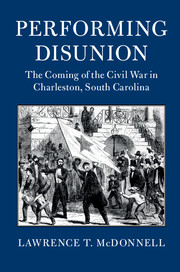15 - A Revolution in Hats
from CONTRADICTIONS: STAND NOBLY TOGETHER
Published online by Cambridge University Press: 08 June 2018
Summary
Across the late 1840s and 1850s, men came to conclude, the fundamental bond between producers and traders, sellers and buyers, borrowers and lenders, had broken down. In the boom times of cotton and rice production in the Carolinas, seemingly everyone got rich as acreage expanded, demand skyrocketed, and prices spiraled up. The opening of new territory in the Gulf states increased competition for capital and slave labor, even as cotton prices fell. Older lands in the piedmont – Carolina's best acreage – wore desperately as farmers worked the soil without ease or rest, but this only drove up the price of more marginal acreage, drawing labor from bottom lands into sandy pine scrub: it was like watching a match burn down. The depression of 1837– slowed that burning, draining slave labor off to the southwest, and easing the relentless drive to grow more cotton: there was less credit to propel growth. But as that crisis passed off and foreign capital came back in, planters and merchants faced the question of how to use the credit that landed in their scarcely profitable hands: pay down debt and wait for the soil to restore itself? Ramp up production, expand acreage, buy slaves, and revive lands as best they could? Would greater output justify greater risk? That was the problem planters, bankers, and all who depended on them had to get right.
“Out of debt, out of trouble!” promised the conservative Courier. Retrenchment was never a realistic option, but Carolinians in the 1850s got the formula for recovery disastrously wrong. “We are gamblers in our ventures,” one planter summed up. “We dare the gamblers loss to win the gamblers gains.” Placing all their hopes on the funds that must flow from the profits of higher cotton production – just as farmers and merchants from Egypt to Brazil to Australia were making the same bet – agriculturists and their allies helped pile up mountains of cotton bales in the warehouses of Liverpool and Manchester. That surplus was bound to strangle Southern hopes before long.
- Type
- Chapter
- Information
- Performing DisunionThe Coming of the Civil War in Charleston, South Carolina, pp. 301 - 322Publisher: Cambridge University PressPrint publication year: 2018



